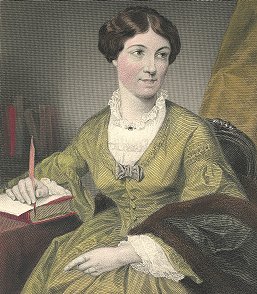Harriet Martineau (1802-1876)
By Riva Berleant

Biography
Harriet Martineau's sense of her own remarkable life led her to recount it and to arrange that the autobiography be published after her death in 1876. Martineau was born of Huguenot ancestry in Norwich, England, in 1802. Her father was a manufacturer, and her mother's family were, ironically, sugar refiners. The progressive Unitarian Martineaus saw to it that all their children, boys and girls alike, were well and equally educated. (Martineau 1877: 1-21). By the time she was fifteen Martineau was, in her own words, 'becoming a political economist without knowing it' (55). She had already read Thomas Malthus and had begun to think seriously in sociological and political modes. She was, in fact, among the first sociologists, though not much recognized in standard histories of that discipline.By the time she was sixteen, she was forced to face and deal with increasing deafness, which she described as 'very noticeable, very inconvenient, and excessively painful.' She taught herself how to manage her handicap so that she could take in what she needed in unobtrusive ways (55-7).
After her father died in 1825 Martineau supported herself by writing, mostly popular journalism with a political economy cast. Her first successes were her Illustrations of Political Economy (1832-1934). These consisted of twenty-four stories that illustrated for a popular audience the ideas of Thomas Malthus, James Mill, David Ricardo, and Adam Smith. They appeared in monthly instalments and sold more copies at the time than the novels of Charles Dickens. She earned enough to be able to move to London in 1832 (Hoecker-Drysdale 1992:34).
The Illustrations include her earliest attacks on slavery, along with anti-slavery articles published in the Monthly Repository, a Unitarian critical journal. She built her arguments on two grounds, the immorality of slavery, and its economic inefficiency. The fourth story in Illustrations, 'Demerara,' exposes the intense human suffering that results from irrational slave systems that waste both capital and labour (Martineau 1832-34, vol. 1: 142-143).
Between 1834 and 1836, Martineau travelled through the United States. She made lasting friends among the Transcendentalists and anti-slavery factions in Boston. Admiration and controversy followed her everywhere. Society in America (1837), like Alexis DeToqueville's better-known work, described and interpreted many features of North American behaviour, institutions, and daily life. Anticipating Max Weber, Martineau argued that moral values undergird social institutions. In the United States, the institution of slavery made 'mockery' of American stated ideals of freedom (219). In the chapter 'Morals of Slavery' she reiterated and destroyed, one by one, the pro-slavery arguments that were promoted in the United States, and questioned whether 'social virtues are possible in a society of which injustice is the primary characteristic.' Her critical mode was irony rather than outrage. On slaveholders, for example, she wrote: 'I could not but marvel at their mild forbearance under the hourly provocations to which they are liable in their homes: their rooms dirty, their property wasted, their plans frustrated, their infants slighted, themselves deluded by artifices' (220-21). Their single virtue was forbearance, for 'the inherent injustice of the system extinguishes all others, and nourishes a whole harvest of false morals toward the rest of society' (223). In plain, harsh language that was extraordinary for her time, she described the sexual degradation of women, both slave and free, the damage to all children, the warping of conscience and behaviour, and a society running on hypocrisy, suspicion, and restriction of liberty (223-237). Not even New England escaped her explosive critique as she described what free people of colour endured there (122-124).
In 1839 Martineau became chronically ill and, by 1855, she was housebound. British slavery and apprenticeship had ended, but Martineau did not allow invalidism to hinder her fight to end slavery in the United States. In 1857, for example, she wrote that despite 'many bodily troubles, I earn lots of money for the American abolitionists by fancy-work' (Sanders 1990:151). Her 'last piece of embroidery fetched 100 dollars for 'the cause' in America' (141).
She kept up her anti-slavery writing until the American Civil War as English correspondent for the American Anti-Slavery Standard (Sanders 1990:205). She continued her social and economic research, the basis for a continuous flow of anti-slavery articles. As always, her moral principles infused her writing, which reveals an acute observer and critic of the politics of slavery and anti-slavery in the United States. Like her contemporary, Joseph Sturge, she saw the connections between slavery in the colonies and working-class oppression at home, even though she had objections against as well as agreements with the British Chartists (Martineau 1877, vol. 1:1). She too, like Sturge, favoured immediate rather than gradual emancipation. She rejected her youthful laissez-faire economic philosophy and strongly urged governmental action to end chattel slavery, wage slavery, and class oppression (Fladeland 1982:73-74).
Martineau's important writings include, in addition to those already described, her Retrospect of Western Travel, another book about the United States (1838), a novel, Deerbrook (1839), and an account of the history and practice of Judaism, Christianity, and Islam, Eastern Life Present and Past (1848). Her journalism, always pointed, accessible, intelligent, and socially conscious, interpreted the politics and society of her time for a wide readership. In 1831 she disclaimed Unitarianism, liberal as it is, in favour of freethinking (1877, vol. 1:119-121). In 1853 she published an abridged translation of Auguste Comte's Cours de Philosophie Positive (1877, vol. 2:57-58; 1853). She enthusiastically embraced positive science as the foundation of a new morality (Hoecker-Drysdale 1992:110-11). Her own life exemplifies the feminism that infuses all her work, no matter its topic (David 1987:46). Harriet Martineau was extraordinary both as a Victorian woman and influential abolitionist writer.
Text © Riva Berleant, 2004
Engraving of Harriet Martineau by Evert A. Duykinck from A Portrait Gallery of Eminent Men and Women of Europe and America, with Biographies, 2 vols (New York: Johnson, Wilson and Company, 1873). Image courtesy of The James Smith Noel Collection
Bibliography
Selected Works
- Deerbrook, 3 vols (London: Edward Moxon, 1839).
- Eastern Life: Present and Past, 3 vols (London: Edward Moxon, 1848)
- Harriet Martineau's Autobiography, 2 vols, ed Maria Weston Chapman (Boston: James R. Osgood & Co, 1877)
- Illustrations of Political Economy, 9 vols (London: Charles Fox, 1832-34)
- The Martyr Age of the United States (Boston: Weeks, Jordan, 1839)
- The Positive Philosophy of Auguste Comte, 2 vols (London: Chapman 1853)
- Retrospect of Western Travel, 3 vols (London: Saunders and Otley, 1838)
- Society in America, 3 vols (London: Saunders and Otley, 1837), rpr. ed Seymour Martin Lipset, (Garden City: Doubleday Anchor Books, 1961)
- Harriet Martineau: Writings on Slavery and the American Civil War ed Deborah Anna Logan (DeKalb, IL: Northern Illinois University Press, 2002)
- Martineau's complete works are currently being made available by Pickering and Chatto, under the general editorship of Deborah Logan. For more information visit Pickering's Martineau page
Selected Secondary Works
- David, Deirdre, Intellectual Women and Victorian Patriarchy, (Ithaca: Cornell University Press, 1987)
- Fladeland, Betty, '"Our Cause Being One and the Same": Abolitionists and Chartism', in Slavery and British Society, 1776-1846, ed James Walvin (Baton Rouge: Louisiana State University Press, 1982), pp. 69-99
- Hoecker-Drysdale, Susan, Harriet Martineau: First Woman Sociologist (New York: Berg, 1992)
- Pichanick, Valerie Kossew, Harriet Martineau: the Woman and Her Work, 1802-76 (Ann Arbor: University of Michigan Press, 1980)
- Romano, Mary Ann, ed, Lost Sociologists Rediscovered (Lampeter: Edwin Mellon Press, 2002)
- Sanders, Valerie, Harriet Martineau: Selected Letters (Oxford: Clarendon Press, 1990)
Links
- The Martineau Society
'The object of the Society shall be to foster the collection, preservation, study and publication in the public interest of material relating to the Martineau family of Norwich in the 19th Century and the principles of freedom of conscience advocated by Harriet Martineau and her brother, Dr James Martineau.' - Harriet Martineau
Entry in The Dictionary of Unitarian and Universalist Biography, a resource hosted by the Unitarian Church.
The Contributor
Riva Berleant Ph.D., is Professor of Anthropology (emerita) in the Department of Anthropology at the University of Connecticut. She has published several books and articles relating to plantations, slavery, the Caribbean region, and missionization.E-mail: berleant@uconnvm.uconn.edu



